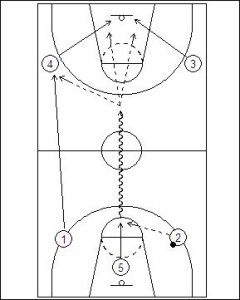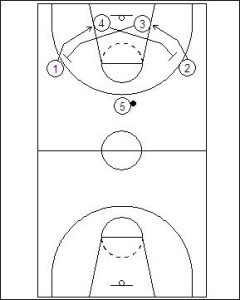Primary Transition: Middle Lane Runner
In basketball, the Primary Transition is the bridge between a team’s initial possession and scoring opportunity. A good Primary transition will set a team apart from their competitors in bringing pace, control, and opportunity to the ongoing progression of the ball. The Middle Lane Runner Play looks to progress the ball as fast as possible up the floor for a high-octane primary transition. There is no delay of progress by slowing the play at any stage.
In the Primary Transition Middle Lane Runner Play, a concern for some teams will be that the rebounder or inbounder ends up handling the ball at pivotal stage of the offense. This may or may not be of concern for a team depending on the ability and style of play the team is accustom to. This tactic will of course, for smaller teams who play individuals out of position for lack of a true Center will find this primary transition exceptionally fast and explosive.
An interesting feature to this primary transition is during the last phase the lane runners swing through the keyway and return back up the floor to set up screens for the trailing lane runners. As the game progresses and the opposition become a little slower, this may see the screens being able to be set higher and higher up the floor. The higher these screens can be set up the floor the less likely the defensive players will be aware of where the screens are and this will allow for greater advantage for the offensive players using the screens. As they will definitely be able to break free of their match-up.

Five (5) rebounds or inbounds the ball and outlets to either of the guards (One or Two). Both guards must be working hard to create a lead for the ball.
The Two (2) receives the outlet pass and squares up to the offensive end of the floor. Two (2) is looking initially for the wide lane runners (Three and Four) to see if they have broken free of their defensive match-up and are capable of receiving a pass.
Four (4) and Three (3) run the outside lanes of the court. Both players should be in a full sprint to reach the three-point line as quickly as possible.

Five (5) sprints the middle lane anticipating a pass from Two (2).
As the guard who did not receive the outlet pass, One (1) trails down the far side of the floor anticipating a pass from Two (2).
Two (2) either passes to Five (5) or One (1) on the break.
Five (5) or One (1) if they receive the pass bust to the middle with a speed dribble and then look to pass ahead to lane runners Four (4) or Three (3). The fewer dribbles the receiver of the pass can take before pushing the ball ahead, the quicker the primary transition will be.

If Four (4) or Three (3) are not able to receive a pass and score, they will cross over and set up-screens for One (1) and Two (2).
If no scoring opportunity presents Five (5) will pass the ball to either side of the floor and dive to the basket and present a strong post target.
The Primary Transition Middle Lane Runner Play looks to provide quick hit options, but then follows this with a secondary action that can be very effective if executed well in the form of up-screens.







